
John Donne was an English poet, scholar, soldier and secretary born into a recusant family, who later became a cleric in the Church of England. Under royal patronage, he was made Dean of St Paul's Cathedral in London (1621–1631). He is considered the preeminent representative of the metaphysical poets. His poetical works are noted for their metaphorical and sensual style and include sonnets, love poems, religious poems, Latin translations, epigrams, elegies, songs and satires. He is also known for his sermons.

St Olave's Church, Hart Street, is a Church of England church in the City of London, located on the corner of Hart Street and Seething Lane near Fenchurch Street railway station.
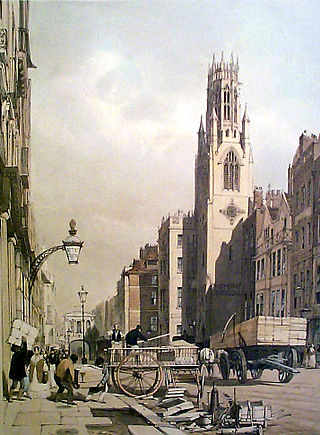
The Guild Church of St Dunstan-in-the-West is in Fleet Street in the City of London. It is dedicated to Dunstan, Bishop of London and Archbishop of Canterbury. The church is of medieval origin, although the present building, with an octagonal nave, was constructed in the 1830s to the designs of John Shaw.

Sir William Reid Dick, was a Scottish sculptor known for his innovative stylisation of form in his monument sculptures and simplicity in his portraits. He became an Associate of the Royal Academy in 1921 and a Royal Academician in 1928. Dick served as president of the Royal Society of British Sculptors from 1933 to 1938. He was knighted by King George V in 1935. He was Sculptor in Ordinary for Scotland to King George VI from 1938 to 1952, then held the post under Queen Elizabeth until his death in 1961.
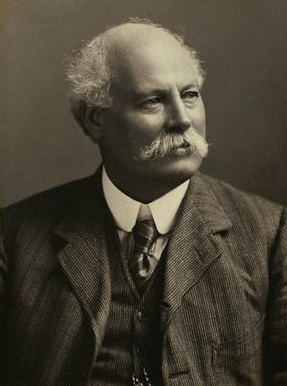
Sir Thomas Brock was an English sculptor and medallist, notable for the creation of several large public sculptures and monuments in Britain and abroad in the late nineteenth and early twentieth centuries. His most famous work is the Victoria Memorial in front of Buckingham Palace, London. Other commissions included the redesign of the effigy of Queen Victoria on British coinage, the massive bronze equestrian statue of Edward, the Black Prince, in City Square, Leeds and the completion of the statue of Prince Albert on the Albert Memorial.

Matthew Noble was a leading British portrait sculptor. Carver of numerous monumental figures and busts including work, memorializing Victorian era royalty and statesmen, displayed in locations such as Westminster Abbey, St Paul's Cathedral and Parliament Square, London.

Sir Edgar Bertram Mackennal, usually known as Bertram Mackennal, was an Australian sculptor and medallist, most famous for designing the coinage and stamps bearing the likeness of George V. He signed his work "BM".
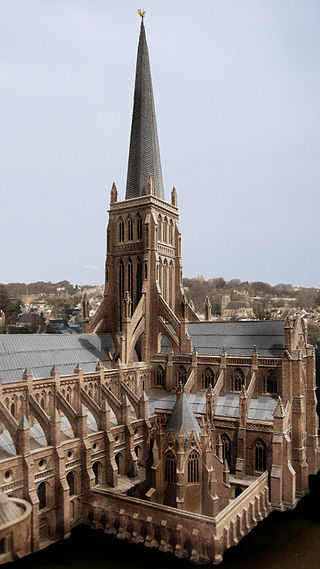
Old St Paul's Cathedral was the cathedral of the City of London that, until the Great Fire of 1666, stood on the site of the present St Paul's Cathedral. Built from 1087 to 1314 and dedicated to Saint Paul, this building was perhaps the fourth such church at this site on Ludgate Hill, going back to the 7th century.
Simeon Fox, M.D. (1568–1642) was an English physician, who became President of the College of Physicians.
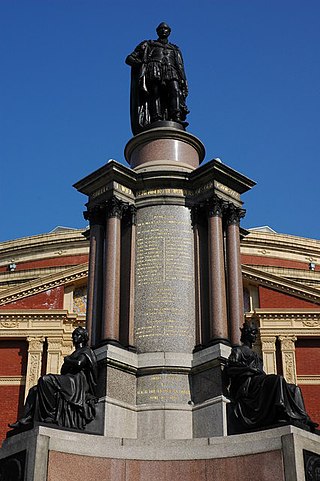
Joseph Durham was an English sculptor.

The Bromley Parish Church Memorial commemorates the deceased parishioners of World War I. The war memorial was designed and constructed by British sculptor Sydney March, of the March family of artists.

The statue of Benjamin Disraeli is an outdoor bronze sculpture by Mario Raggi, located at the west side of Parliament Square in London. It was unveiled in 1883 and became a Grade II listed building in 1970.

A 1965 memorial bust of John F. Kennedy by Jacques Lipchitz stands in the lobby of International Students House on Great Portland Street in London, England, and is visible from the outside through the glass doors. It was moved there in April 2019 from its original location on the Marylebone Road, to the west of Great Portland Street underground station, after it was vandalised in 2017.

The Joseph Lister Memorial is a memorial to Joseph Lister, 1st Baron Lister by the sculptor Thomas Brock, situated in Portland Place in Marylebone, London. The memorial is positioned in the centre of the road opposite numbers 71 to 81 and is Grade II listed. It is close to Lister's home at 12 Park Crescent.

Twelve Responses to Tragedy, or the Yalta Memorial, is a memorial located in the Yalta Memorial Garden on Cromwell Road in South Kensington in west London. The memorial commemorates people displaced as a result of the Yalta Conference at the conclusion of the Second World War. Created by the British sculptor Angela Conner, the work consists of twelve bronze busts atop a stone base. The memorial was dedicated in 1986 to replace a previous memorial from 1982 that had been repeatedly damaged by vandalism.

The Burdett-Coutts Memorial Sundial is a structure built in the churchyard of Old St Pancras, London, in 1877–79, at the behest of Baroness Burdett-Coutts. The former churchyard included the burial ground for St Giles-in-the-Fields, where many Catholics and French émigrés were buried. The graveyard closed to burials in 1850, but some graves were disturbed by a cutting of the Midland Railway in 1865 as part of the works to construct its terminus at St Pancras railway station. The churchyard was acquired by the parish authorities in 1875 and reopened as a public park in June 1877. The high Victorian Gothic memorial was built from 1877 and unveiled in 1879. The obelisk acts as a memorial to people buried near the church whose graves were disturbed; the names of over 70 of them are listed on the memorial, including the Chevalier d'Éon, Sir John Soane, John Flaxman, Sir John Gurney, and James Leoni.
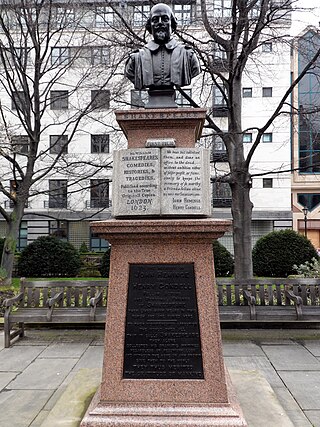
The John Heminges and Henry Condell Memorial is a memorial to the actors John Heminges and Henry Condell – the editors of William Shakespeare's First Folio, published in 1623 – in the former churchyard of St Mary Aldermanbury on Love Lane, London EC2. The memorial is made from pink granite and is topped with a bust of Shakespeare by C. J. Allen, dated 1895.

The Memorial to Dr Barnardo by George Frampton, at Barkingside in the London Borough of Redbridge, commemorates the founder of the Barnardo's children's charity. Born in Dublin into a Sephardic Jewish family, Thomas John Barnardo moved to the East End of London in 1866 where he established a chain of orphanages that developed into the Barnardo's charity. He died in 1905 and, in a move unusual for the time, was cremated; his ashes were interred in front of Cairn's House, the original building of his Barkingside children's village. In 1908, a memorial was raised on the site, the sculpture being undertaken by George Frampton, who worked without a fee. The memorial was designated a Grade II listed structure in 1979 and upgraded to II* in 2010.

The Memorial to Arthur Sullivan by William Goscombe John stands in Victoria Embankment Gardens in the centre of London. It was designated a Grade II listed structure in 1958.



















